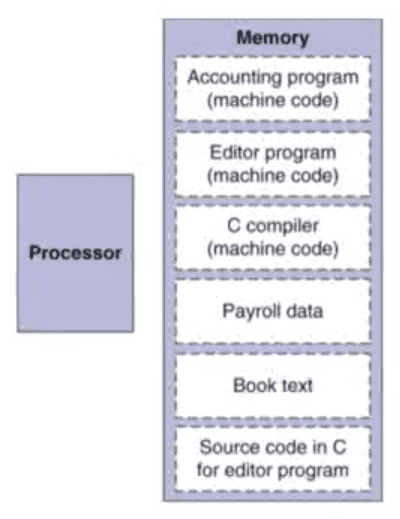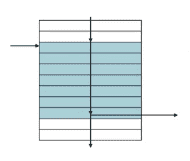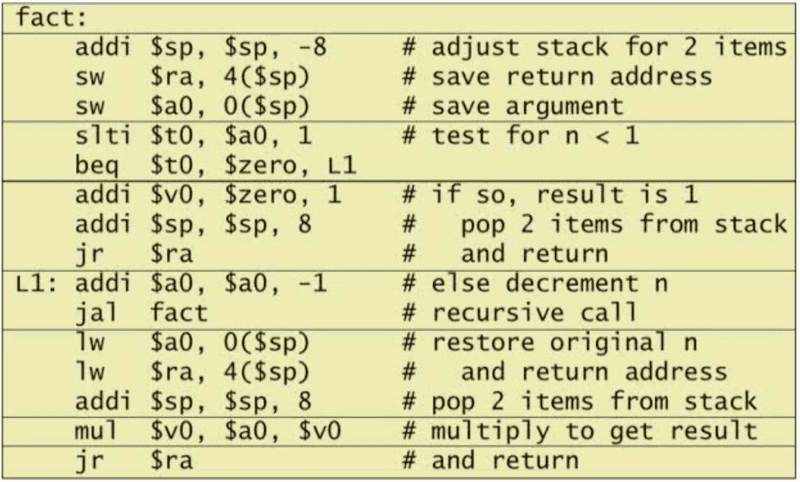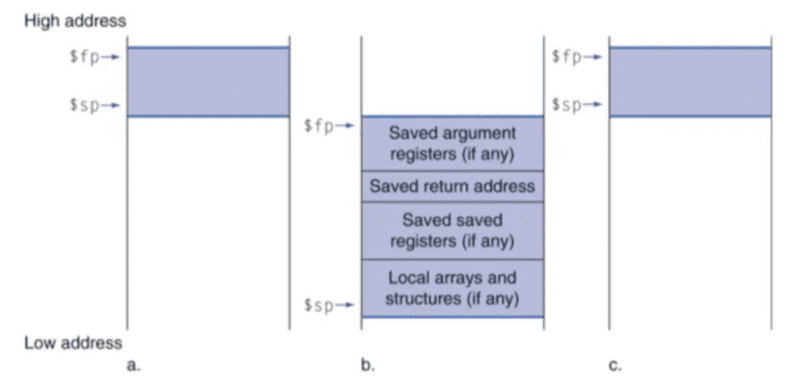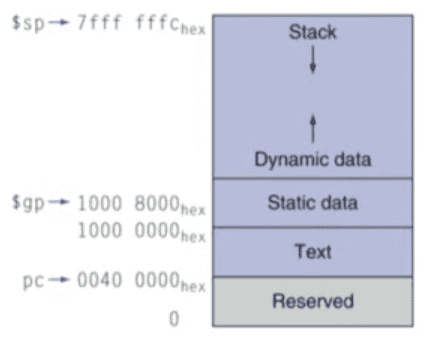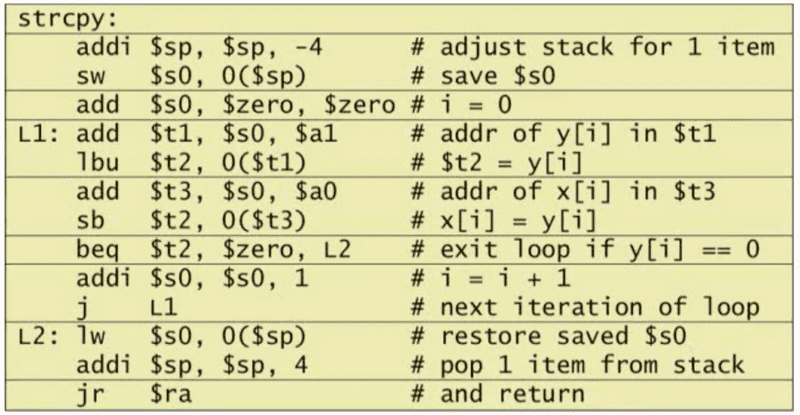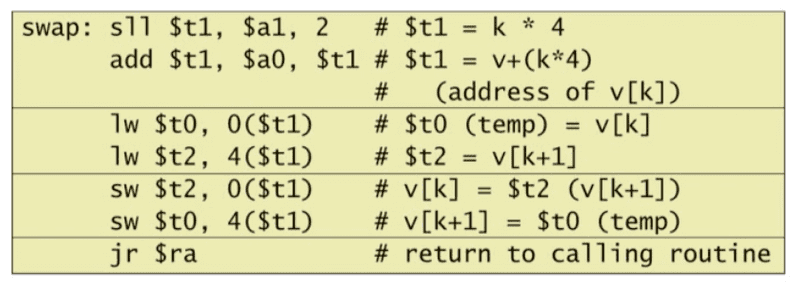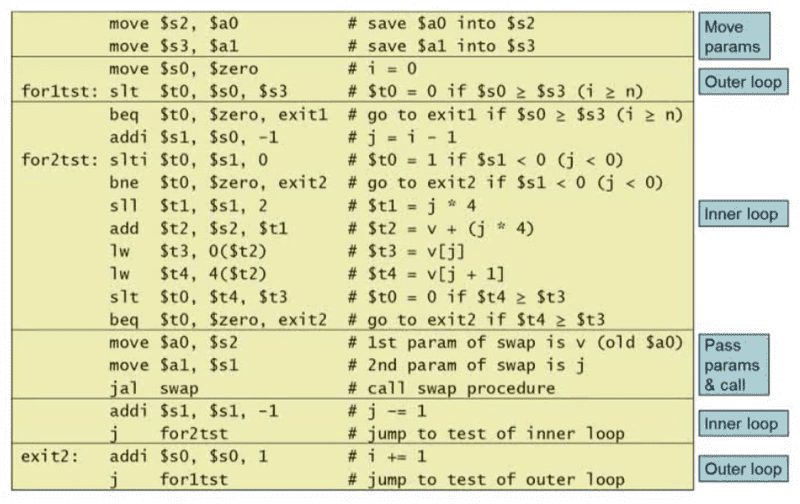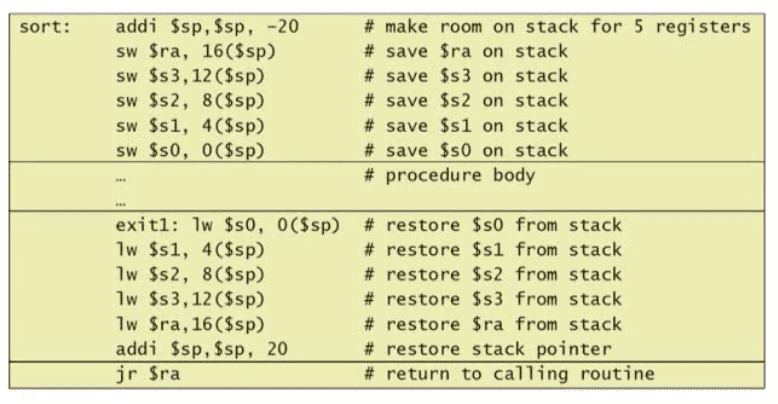[컴퓨터구조론] 2. Instructions: Language of the Computer
2020-06-24
본 글은 영남대학교 최규상 교수님의 컴퓨터 구조 강의를 듣고 작성된 글입니다.
2.1 Introduction
-
Instruction Set
- 명령어들의 집합(레퍼토리)이다.
- 컴퓨터 마다 다른 Instruction Set을 가지지만 많은 공통점을 가지고 있다.
- 초창기 컴퓨터들은 매우 단순한 Instruction Set을 가지고 있었다.(명령어의 수, 종류가 적었다는 뜻)
-
많은 최신 컴퓨터(CPU) 또한 simple instruction sets을 가진다.
- 물론 초창기와 최신 컴퓨터 사이에 complex instruction set을 가지는 컴퓨터도 존재한다.
- 즉, 단순 -> 복잡 -> 단순의 과정을 거쳐왔다.
-
Instruction Set Architecture (ISA)
- 간단히 ISA 또는 아키텍쳐라고 불린다.
- 하드웨어와 low level software(시스템 소프트웨어, 운영체제) 사이의 인터페이스이다.
- 명령어, 레지스터, 메모리 접근, I/O 등 기계언어 프로그램을 쓰기위해 필요한 모든 정보를 포함하고 있다.
- Enables implementations of varying cost and performance to run identical software
-
Application Binary Interface (ABI)
- ISA와 운영체제 인터페이스(operation system interface)를 합친 것이다.
- ABI에서 어떠한 소프트웨어가 동작한다면 어떤한 머신에서도 동일한 ABI로 소프트웨어를 동작시킬 수 있다.
-
The MIPS Instruction Set(MIPS의 Instruction Set에 대해서 배워보자!)
- MIPS는 우리가 1장에서 배운바와같이 Millions of Instructions Per Second를 의미하기도 하지만 CPU이름이기도 하다.
- MIPS는 처음 스탠포드에서 제안하였고 MIPS Technologies에서 상용화했다.
- 임베디드 시장에서 많이 쓰인다.(최근에는 ARM이 많이 쓰이긴 한다.)
- MIPS에서 사용하는 알고리즘과 특성은 많은 다른 CPU들과 공통점을 가진다.
2.2 Operations of the Computer Hardware
-
Arithmetic Operations
- 어셈블리에서 add a, b, c를 실행하면 b와 c를 더해서 a에 할당한다.
- 모든 산술연산은(Arithmetic)은 다음과 같은 형태를 가진다.
2장에서 4개의 디자인 원칙을 배우게 될 것이다. 먼저 첫 번째 디자인 원칙을 만나보자
Design Principle 1: Simplicity favours regularity (Regularity를 사용해서 간단하게 만들어라)
- 어떤 규칙성을 주면 구현할 때 훨씬 편리하다.
- 간단하게 만들어야 낮은 cost로 높은 성능을 낼 수 있다.
2.3 Operands of the Computer Hardware
-
Register Operands
- Arithmetic Operations는 register operands를 사용한다.
-
MIPS는 32bit 레지스터를 32개 가지고 있다.
- 이 레지스터에 자주 사용하는 데이터를 로드해서 사용한다.
- 숫자의 범위는 0 ~ 31 이다.
- 32비트 데이터를 word라고 부른다.(1word = 32bit)
-
어셈블리에서는 t로 시작하는 레지스터와 s로 시작하는 레지스터가 있다.
- $t0, $t1, ..., $t9 for temporary values
- $s0, $s1, ..., Ss7 for saved variables(우리가 변수에 저장해서 사용하는 값들)
Design Principle 2: Smaller is faster
c.f. main memory: millions of locations
- 메인메모리는 레지스터에 비교하면 훨씬 크다. 그래서 메인메모리에 접근하는 시간이 레지스터에 접근하는 시간보다 훨씬 오래 걸린다.
-
Register Operand 예제
- C code: f = (g + h) - (i + j); -f,...,j in $s0,...,$s4
-
Compiled MIPS code:
add $t0, $s1, $s2 add $t1, $s3, $s4 sub $s0, $t0, $t1
-
Byte Address
- 8 비트가 유용하기 때문에, 대부분의 컴퓨터의 메모리는 바이트 단위로 주소를 지정한다.
- Alignment restriction - the memory address of a word must be on natural word boundaries (a multiple of 4 in MIPS-32)
-
Endian: 데이터를 워드에 어떤 방식으로 저장할 것인가를 말하는 것
-
Big Endian: leftmost byte is word address
- IBM 360/370, Motorola 68k, MIPS, Sparcm HP PA
-
Little Endian: rightmost byte is word address
- Intel 80x86, DEC Vax, DEC Alpha (Windows NT)
-
-
Memory Operands
-
Main memory used for composite data
- Arrays, structures, dynamic data
-
To Apply arthmetic operations
- Load values from memory innto registers
- Store result from register to memory
-
Memory is byte addressed
- Each address identifies an 8-bit byte
-
Words are aligned i nmemory
- Address must be a multiple of 4
-
MIPS is Big Endian
- Most-significant byte at least address of a word
- c.f. Little Endian: least-significant byte at least address
-
-
Memory Operand Example 1
-
C code: g = h + A[8];
- g in $s1, h in $s2 base address of A in $s3
-
Compiled MIPS code:
-
Index 8 requires offset of 32
-
4 bytes per word
lw $t0, 32($s3) # lw: load word add $s1, $s2, $t0
-
-
-
-
Register vs Memory
- Registers are faster to access than memory
-
Operating on memory data requires loads and stores (Load-Store Architecture)
- More instructions to be executed
-
Compiler must use registers for variables as much as possible
- Only spill to memory for less frequently used variables
- Register optimization is important!
-
레지스터
-
메인 메모리보다 빠르다
- But register files with more locations are slower
- e.g. a 64 word file could be as much as 50% slower than a 32 word file
- Read/write port increase impacts speed quadratically
-
컴파일러가 사용하기 더 쉽다(Easier for a compiler to use)
- e.g. (A*B) - (C*D) - (E*F) can do multiplies in any order vs stack
-
Can hold variables so that
- code density improves (since register are named with fewer bits than a memory location. 레지스터의 경우 5bits, 메모리의 경우 32bits)
- density가 높다? 코드의 직접도가 높다는 것이고 적은 코드로 어떠한 일을 수행할 수 있다는 것. 즉 같은 일을 하더라도 명령의 수가 적다.
-
- MIPS Register Convention
-
Immediate Operands
-
Constant data specified in an instruction
- addi $s3, $s3, 4
-
No subtract immediate instruction
- Just use a negative constant
- addi $s2, $s1, -1
-
Design Principle 3: Make the common case fast
- Small constants are common
- Immediate operand avoids a load instruction
-
The Constant Zero
-
MIPS register 0($zero) is the constant 0
- Cannot be overwritten
-
Useful for common operations
- E.g., move between registers
- add $t2, $s1, $zero
-
2.4 Signed and Unsigned Numbers
-
Unsigned Binary Integers
-
2s-Complement(2의 보수) Signed Integers
-
Signed Negation
- Complement and add 1
- 여기서 Complement란 1 -> 0, 0 -> 1와 같이 바꿔주는 것
-
Sign Extension
-
Representing a number using more bits(2진수를 8진수, 32진수와 같이 더큰 진수로 나타내는 것. 그리고 이 때 값과 부호는 유지되어야 한다.)
- Preserve the numeric value
-
In MIPS instruction set
- addi: extend immediate value
- lb, lh: extend loaded byte/halfword
- beq, bne: extend the displacement
-
Replicate the sign bit to the left
- c.f. unsigned values: extend with 0s
-
Examples: 8-bit to 16-bit
- +2: 0000 0010 => 0000 0000 0000 0010
- -2: 1111 1110 => 1111 1111 1111 1110
-
2.5 Representing Instructions in the Computer
-
Representing Instructions
-
Instructions are encoded in binary
- Called machine code
-
MIPS instructions
- Encoded as 32-bit instruction words
- Small number of formats encoding operationn code (opcode), register numbers, ...
- Regularity!(이전에 이야기했던 디자인 원칙 1에 해당)
-
Register numbers
- $t0 - $t7 are reg's 8 - 15
- $t8 - $t9 are reg's 24 - 25
- $s0 - $s7 are reg's 16 - 23
-
-
MIPS R-format Instructions
-
Hexadecimal
-
Base 16
- Compact representation of bit strings
- 4 bits per hex digit
-
-
MIPS I-format Instructions
Design Principle 4: Good design demands good compromises
- Different formats complicate decoding, but allow 320bit instructions uniformly
- Keep formats as similar as possible
- MIPS I-format instructions를 살펴보면 Immediate arithmetic 과 load/store instructions는 서로 다른 명령이지만 같은 포맷을 가진다. 이것이 바로 good compromises.
-
- Instructions represented in binary, just like data
- Instructions and data stored in memory
-
Programs can operate on programs
- e.g., compilers, linkers, ...
-
Binary comptibility allows compiled programs to work on different computers
- 표준화된 ISA가 지원되면 가능하다.(Standardized ISAs)
2.6 Logical Operations
-
Logical Operations(논리 연산)
- Instructions for bitwise manipulation
Operation C Java MIPS Shift left << << sll Shift right >> >>> srl Bitwise AND & & and, andi Bitwise OR | | or, ori Bitwise NOT ~ ~ nor - Useful for extracting and inserting groups of bits in a word
-
Shift Operations
- shamt: how many positions to shift
-
Shift left logical
- Shift left and fill whit 0 bits
- sll bt i bits multiplies by 2^i
-
Shift right logical
- Shift right and fill with 0 bits
- srl by i bits divides by 2^i (unsigned only)
-
AND Operations
-
Useful to mask bits in a word
- Select some bits, clear others to 0
-
-
OR Operations
-
Useful to include bits in a word
- Set some bits to 1, leave others unchanged
-
-
NOT Operations
-
Useful to innvert bits in a word
- Change 0 to 1, and 1 to 0
-
MIPS has NOR 3-operand instruction
- a NOR b == NOT (a OR b)
-
2.7 Instructions for Making Decisions
-
Conditional Operations
-
Branch to a labeled instruction if a condition is true
- Otherwise, continue sequentially
-
beq rs, rt, L1
- if (rs == rt) branch to instruction labeled L1;
-
bne rsm rtm L1
- if (rs != rt) branch to instruction labeled L1;
-
j L1
- unconditional jump to instruction labeled L1
-
-
Compiling If Statements
-
C code
if (i==j) f = gh; else f = g-h;- f, g, ... in $s0, $s1, ...
-
Compiled MIPS code
bne $s3, $s4, Else add $s0, $s1, $s2 j Exit Else: sub $s0, $s1, $s2 Exit: ... <- Assembler calculates addresses
-
-
Compiling Loop Statements
-
C code
while (save[i] == k) i += 1;- i in $s3, k in $s5, address of save in $s6
-
Compiled MIPS code
Loop: sll $t1, $s3, 2 add $t1, $t1, $s6 lw $t0, 0($t1) bne $t0, $s5, Exit addi $s3, $s3, 1 j Loop Exit: ...
-
-
Basic Blocks
-
More Conditional Operations
-
Set result to 1 if a condition is true
- Otherwise, set to 0
-
slt rd, rs, rt
- if(rs<rt) rd = 1; else rd = 0;
-
slti rt, rs ,constant
- if(rs<constant) rt = 1; else rt = 0;
-
Use in combination with beq, bne
slt $t0, $s1, $s2 # if ($s1 < $s2) bne $t0, $zero, L # branch to L
-
-
Branch Instruction Design
- Why not blt, bge, etc?
-
Hardware for <, >=, ... slower than =, !=
- Combining with branch involves more work per instruction, requiring a slower clock(clock period)
- All instructions penalized!
- beq and bne are the common case
- This is good design compromise
-
Signend vs Unsigned
- Siged comparison: slt, slti\
- Unsigned comparison: sltu, sltui
2.8 Supporting Procedures in Computer Hardware
-
Six Steps in Execution of a Procedure(프로시져 또는 함수)
-
Main routine (caller: 호출하는 함수) places parameters in a place where the procedure (callee: 호출당하는 함수) can access them(caller는 callee가 접근할 수 있는 곳에 매개변수를 위치시킨다.)
- $a0 - $a3: four argument registers
- Caller는 calllee에게 control을 넘긴다.(callee가 실행된다.)
- Callee는 필요한 저장공간(메모리)를 할당 받는다.
- Callee는 해야할 일을 수행한다.
-
할 일을 모두 마친 Callee는 결과값(return 값)을 caller가 접근할 수 있는 곳에 위치시킨다.
- $v0 - $v1: two value registers for result values
-
Callee가 caller에게 control을 넘긴다.
- $ra: one return address register to return to the point of origin
-
-
Register Usage
- $a0 - $a3: arguments(reg's 4 - 7)
- $v0, $v1: result values(reg's 2 and 3)
-
$t0 - $t9: temporaries
- Can be overwritten by callee
-
$s0 - $s7: saved
- Must be saved/restored by callee
- $gp: global pointer for static data(reg 28)
- $sp: stack pointer(reg 29)
- $fp: frame pointer(reg 30)
- $ra: return address(reg 31)
-
Procedure Call Instructions
-
Procedure call: jump and link
- jal ProcedureLabel
- Address of following instruction put in $ra
- Jumps to target address
-
Procedure return: jump register
- jr $ra
- Copies $ra to program counter (program counter란? 줄여서 pc라고도 불림, 현재 실행하고있는 명령어의 메모리 주소를 가리키는 레지스터)
-
Can also be used for computed jumps
- e.g., for case/switch statements
-
-
Leaf Procedure Example (Leaf Procedure: 함수(프로시져) 내부에서 다른 함수(프로시져)를 호출 하지 않는 함수(프로시져))
-
C code
int leaf_example (int g, h, i, j){ int f; f = (g + h) - (i + j); return f; } - Arguments g, ..., j in $a0, ..., $a3
- f in $s0 (hence, need to save $s0 on stack)
- Result in $v0
-
MIPS code
leaf_example: # Save $s0 on stack addi $sp, $sp, -4 sw $s0, 0($sp) # 기존에 있을지 모르는 $s0 값을 스택 포인터에 저장 # Procedure body add $t0, $a0, $a1 add $t1, $a2, $a3 sub $s0, $t0, $t1 # Result add $v0, $s0, $zero # move 명령어와 같은 결과(add + $zero) # Restore $s0 lw $s0, 0($sp) # 위에서 저장한 값 복구 addi $sp, $sp, 4 # Return jr $ra
-
-
Non-Leaf Procedures
- Procedures that call other procedures
-
For nested call, caller needs to save on the stack:
- Its return address
- Any arguments and temporaries needed after the call
- Restore from the stack after the call
-
Non-Leaf Procedure Example
-
-
Local data allocated by callee
- e.g., C automatic variables
-
Procedure frame (activation record) (그림에서 보라색으로 칠해진 영역)
- Used by some compilers to manage stack storage
-
-
- Text program code
-
Static data: global variables
- e.g., static variables in C, constant arrays and strings
- $gp initialized to address allowing +-offsets into this segment
-
Dynamic data: heap
- E.g., malloc in C, new in Java
- Stack: automatic storage
- 우리가 코딩하다가 stackoverflow를 만나게 되는 경우? stack이 계속 쌓여 나가다가 dynamic data 영역을 침범하게 될 때
- $gp의 역햘: 여기서 static data의 중앙값을 가지지만 그 값은 프로세서에 따라 다를 수 있다. 하지만 그 목적(역할)은 static data에 수월하게 접근하기 위한 것으로 동일하다.
2.9 Communicating with People
-
Character Data
-
Byte-encoded character sets (1 byte로 표현)
-
ASCII: 128 characters
- 95 graphic, 33 control
-
Latin-1: 256 characters
- ASCII, +96 more graphic characters
-
-
Unicode: 32-bit character set
- Used in Java, C++ wide characters, ...
- Most of the world's alphabets, plus symbols
- UTF-8, UTF-16: variable-length encodings(1 byte 이상의 값으로 표현)
-
-
Byte/Halfword Operations
- Could use bitwise operations
-
MIPS byte/halfword load/store
-
String processing is a common case
lb rt, offset(rs) lh rt, offset(rs) -
Sign extend to 32 bits in rt
lbu rt, offset(rs) lhu rt, offset(rs) -
Zero extend to 32 bits in rt
sb rt, offset(rs) sh rt, offset(rs) - Store just rightmost byte/halfword
-
-
String Copy Example
2.10 MIPS Addressing for 32-Bit Immediates and Addresses
-
32-bit Constants
-
Most constants are small
- 16-bit immediate is sufficient
-
For the occasional 32-bit-constant
lhi rt, constant- Copies 16-bit constant to left 16 bits of rt
-
Clears right 16 bits of rt to 0
lhi $s0, 61 ori $s0, $s0, 2304 # 이와같이 두 개의 명령어를 사용해서 32bit 상수를 만들 수 있다.
-
-
Branch Addressing
-
Jump Addressing
-
Branching Far Away
- If branch target is too far to encode with 16-bit offset, assembler rewrites code
-
Addressing Mode Summary
- Immediate addressing ex) addi
- Register addressing ex) R-type
- Base addressing ex) lw/sw
- PC-relative addressing ex) branch
- Pseudodirect addressing ex) jump
2.11 Parallelism and Instruction: Synchronization
-
Synchronization
-
Two processors sharing an area of memory
- P1 writes, then P2 reads
-
Data race if P1 and P2 don't synchronnize
- Result depends of order of access
-
Hardware support required
- Atomic read/write meomory operation (어떤 오퍼레이션을 할 때 중간에 interrupt가 일어나지 않는 것)
- No other access to the location allowed between the read and write
-
Could be a single instruction
- E.g., atomic swap of register <-> memory
- Or an atomic pair of instructions
-
-
Synchronization in MIPS
- Load linked: ll rt, offset(rs)
-
Store conditional: sc rt, offset(rs)
-
Succeeds if location not changed since the ll
- Returns 1 in rt
-
Fails if locationn is changed
- Returns 0 in rt
-
2.12 Translating and Starting a Program
- Translation and Startup
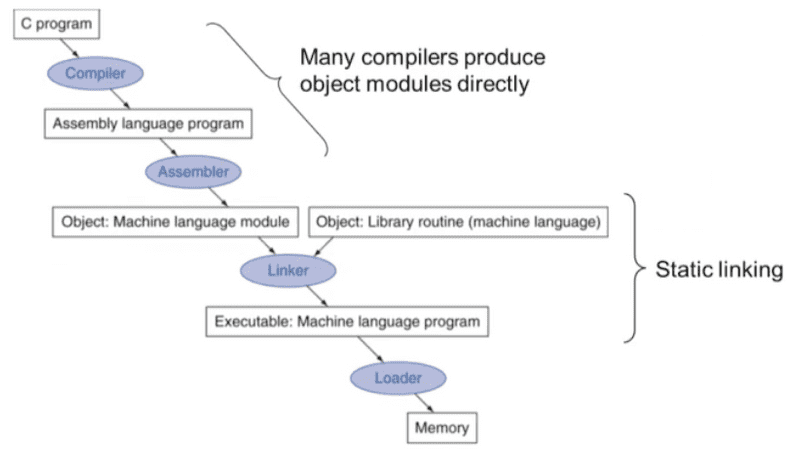
-
Assembler Pseudoinstructions
- Most assembler instructions represent machine instructions one-to-one
- Pseudoinstructions: figments of the assembler's imagination
- MIPS 어셈블러에는 수두인스트럭션이 존재한다. 실제 MIPS에는 존재하지 않는 명령어지만 MIPS에서 사용할 수 있는 가짜 명령어. 이런 경우 어셈블러가 해당되는 실제 MIPS 명령어로 바꿔준다. ex) move
-
Producing an Object Module
- Assembler(or compiler) translates program into machine instructions
-
Provides information for building a complete program from the pieces
- Header: described contents of object module
- Text segment: translated instructions
- Static data segment: data allocated for the life of the program
- Relocation info: for contents that depend on absolute location of loaded program
- Symbol table: global definitions and external refs
- Debug info: for associating with source code
-
Linking Object Modules
-
Produces an executable image
- Merges segments
- Resolve labels (determine their addresses)
- Patch location-dependent and external refs
-
Could leave location dependencies for fixing by a relocating loader
- But with virtual memory, no need to do this
- Program can be loaded into absolute location in virtual memory space
- virtual memory에 있는 절대 주소값을 사용하면 된다는 것(?)
-
-
Load a Program
-
Load from image file on disk into memory
- Read header to determine segment size
- Create virtual address space
-
Copy text and intialized data into memory
- Or set page table entries so they can be faulted in
- Set up arguments on stack
- Initialize registers (including $sp, $fp, $gp)
-
Jump to startup routine
- Copies arguments to $a0, ... and calls main
- When main returns, do exit syscall
-
-
Dynamic Linking
-
Only link/load library procedure when it is called
- Requires procedure code to be relocatable
- Avoids image bloat caused by static linking of all (transitively) referenced libraries
- Automatically picks up new library versions
-
- Lazy Linkage
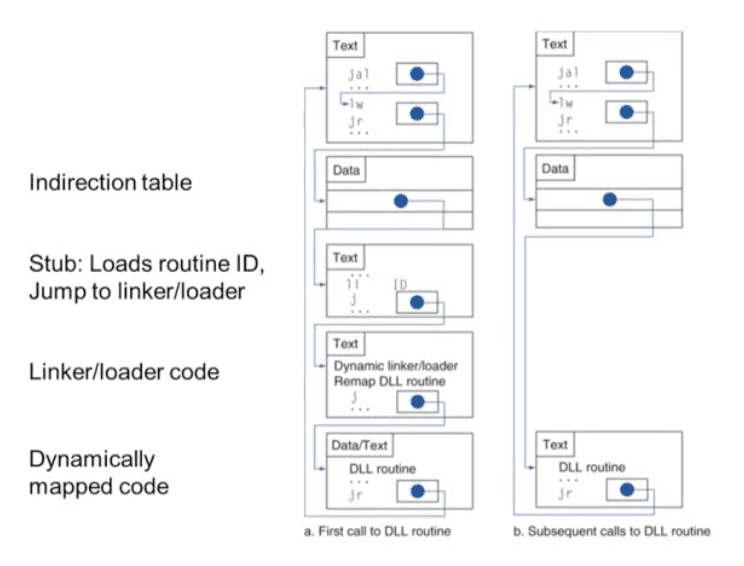
2.13 A C Sort Example to Put it All Together
-
C Sort Example
- Illustrates use of assembly instructionns for a C bubble sort function
-
Swap procedure (leaf)
void swap(int v[], it k){ int temp; temp = v[k]; v[k] = v[k+1]; v[k+1] = temp; } -
The Sort Procedure in C
- Effect of Compiler Optimization
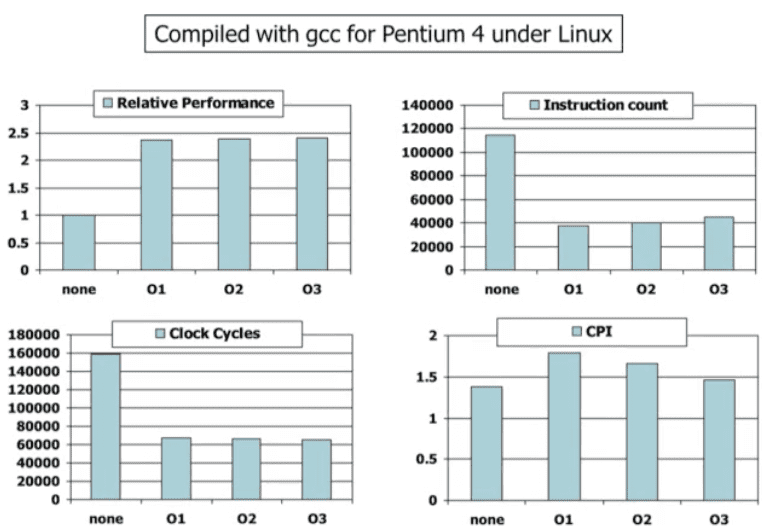
-
Compiler Benefits
- Comparing performance for bubble sort
gcc opt Relative performance Clock cycles(M) Instr cout(M) CPI None 1.00 158,615 114,938 1.38 O1(medium) 2.37 66,990 37,470 1.79 O2(full) 2.38 66,521 39,993 1.66 O3(proc mig) 2.41 65,747 44,993 1.46 - O3가 명령어 수는 O1, O2에 비해 많지만 CPI가 제일 낮아 성능이 제일 좋다.
-
Lessons Learnt
- 명령어 수와 CPI 각각으로는 성능의 좋은 지표가 될 수 없다.
- Compiler optimization are sensitive to the algorithm
-
Java/JIT compiled code is significantly faster than JVM interpreted
- Comparable to optimized C in some cases
- Nothing can fix a dumb algorithm!
2.14 Arrays versus Pointers
-
Arrays vs Pointers
-
Array indexing involves
- Multiplying index by element size
- Adding to array base address
-
Pointers correspond directly to memory addresses
- Can avoid indexing complexity
-
-
- 예제에서 명령어 줄 수는 같지만 loop의 줄 수를 살펴보면 array의 경우는 6줄, pointer의 경우는 4줄이다. 따라서 반복 횟수가 많아질 수 록 pointer로 구현하는 것이 성능이 더 좋다.
-
Comparison of Array vs Ptr
- Multiply "strength reduced" to shift
-
Array version requires shift to be inside loop
- Part of index calculation for incremented!
- c.f. incrementing pointer
-
Compiler can achieve same effect as manual use of pointers
- Induction variable elimination
- Better to make program clearer and safer
- 결론: 컴파일러가 배열을 사용하더라도 포인터를 사용하는 것과 유사한 효과를 준다. 또한 포인터를 사용할 경우 프로그램을 이해하기 까다롭고 배열을 사용하는게 더 이해하기쉽고 버그가 적게 생기므로 배열을 사용하자.
2.16 Real Stuff: ARM Instructions
-
ARM & MIPS Similarities
- ARM: the most popular embedded core
- Similar basic set of instructions to MIPS
ARM MIPS Data announced 1985 1985 Instruction size 32 bits 32 bits Address space 32-bit flat 32-bit flat Data alignment Aligned Aligned Data addressing modes 9 3 Registers 15 * 32-bit 31 * 32-bit I/O Memory mapped Memory mapped -
Compare and Branch in ARM
-
Uses condition codes for result of an arithmetic/logical instruction
- Negative, zero, carry, overflow
- Compare instructions to set condition codes without keeping the result
-
Each instruction can be conditional
- Top 4 bits of instruction word: condition value
- Can avoid branches over single instructions
-
- Instruction Encodeing
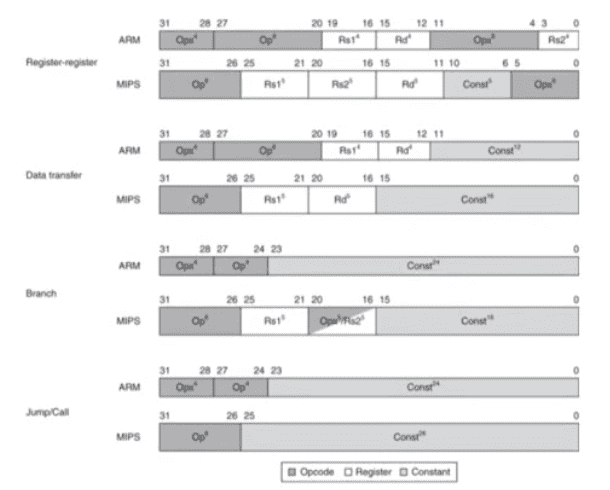
2.17 Real Stuff: x86 Instructions (Intel)
- CISC (Complex Instruction Set Computer)
-
Complex instruction set makes implementation difficult
-
Hardware translates Instruction to simpler microoperations
- Simple instructions: 1-1
- Complex instructions: 1-many
- Microengine similar to RISC
- Market share makes this economically viable
-
-
Comparable performance to RISC
- Compilers avoid complex instructions
2.18 Real Stuff: ARM v8 (64-bit) Instructions
- In moving to 64-bit, ARM did a complete overhaul
-
ARM v8 resembles MIPS
-
Changes from v7:
- No conditional execution field
- Immediate fields is 12-bit constant
- Dropped load/store multiple
- PC is no longer a GPR
- GPR set expanded to 32
- Addressing modes work for all word size
- Divide instruction
- Branch if equal/branch if not equal instructions
-
2.19 Fallacies and Pitfalls
Fallacies
-
Powerful instruction -> higher performance
- Fewer instructions required
- But complex instructions are hard to implement
- Compilers are good at making fast code from simple instructions
-
Use assembly code for high performance
- But modern compilers are better at dealing with mordern processors
- More lines of code -> more errors and less productivity
-
Backward compatibility -> instruction set doesn't change
- But they do accrete more instructions
Pitfalls
-
Sequentail words are not at sequential addresses
- Increment by 4, not by 1!
-
Keeping a pointer to an automatic variable after procedure returns
- e.g., passing pointer back via an argument
- Pointer becomes invalid when stack popped
2.20 Concluding Remarks
-
Design principles
- Simplicity favors regularity
- Smaller is faster
- Make the common casse fast
- Good design demands good compromises
-
Layers of software/hardware
- Compiler, assembler, hardware
-
MIPS: typical of RISC ISAs
- c.f. x86






